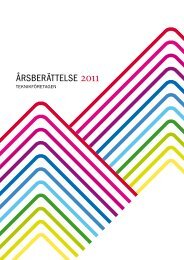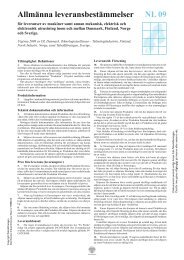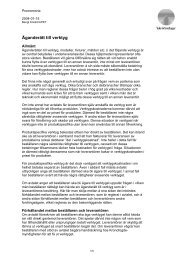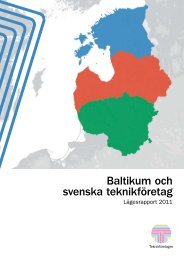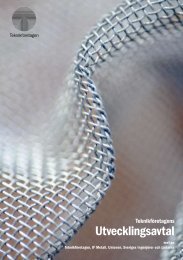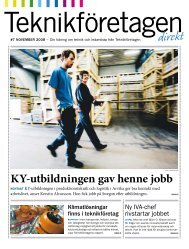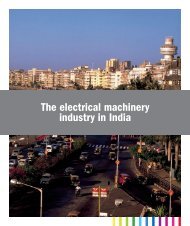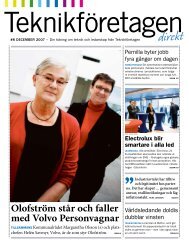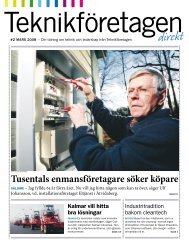in India The Indian automotive components industry - Teknikföretagen
in India The Indian automotive components industry - Teknikföretagen
in India The Indian automotive components industry - Teknikföretagen
- No tags were found...
You also want an ePaper? Increase the reach of your titles
YUMPU automatically turns print PDFs into web optimized ePapers that Google loves.
<strong>The</strong> <strong>India</strong>n <strong>automotive</strong><strong>components</strong> <strong>in</strong>dustry
Foreword<strong>India</strong> has been one of the world’s fastest grow<strong>in</strong>g economies dur<strong>in</strong>g the last fewyears. However, <strong>India</strong> has still not recovered from the effects of the former <strong>in</strong>wardorientedpolicies it followed until the 1990s. Economic reforms started tak<strong>in</strong>g place<strong>in</strong> the beg<strong>in</strong>n<strong>in</strong>g of the 1990s when <strong>India</strong> started open<strong>in</strong>g up gradually. <strong>The</strong> questionis whether <strong>India</strong> can implement the required policy changes effectively and developa conducive bus<strong>in</strong>ess climate for <strong>in</strong>dustry to grow, and thus be able to susta<strong>in</strong>the strong rate of growth it has achieved over the past few years.Dur<strong>in</strong>g this time there has been <strong>in</strong>creas<strong>in</strong>g confidence <strong>in</strong> the manufactur<strong>in</strong>g sector <strong>in</strong><strong>India</strong> and its long term potential as a manufactur<strong>in</strong>g hub. Importance of the eng<strong>in</strong>eer<strong>in</strong>g<strong>in</strong>dustry is supreme <strong>in</strong> this regard and it also plays a crucial role <strong>in</strong> the economicgrowth of the country. To understand the driv<strong>in</strong>g forces of <strong>India</strong> better, it is essentialto develop an understand<strong>in</strong>g of prevail<strong>in</strong>g fundamentals <strong>in</strong> the eng<strong>in</strong>eer<strong>in</strong>g <strong>in</strong>dustry.In this report we provide an overview of the eng<strong>in</strong>eer<strong>in</strong>g <strong>in</strong>dustry <strong>in</strong> <strong>India</strong> withrelevant facts regard<strong>in</strong>g the structure and size, growth rates, ma<strong>in</strong> challenges, trends<strong>in</strong> <strong>in</strong>ternational trade, research and development <strong>in</strong>itiatives, as well as an <strong>in</strong>dicationof future outlook of the ma<strong>in</strong> segments <strong>in</strong> the eng<strong>in</strong>eer<strong>in</strong>g <strong>in</strong>dustry. It is a series ofseven different reports that <strong>in</strong>cludes an overview of the eng<strong>in</strong>eer<strong>in</strong>g <strong>in</strong>dustry, the<strong>automotive</strong> <strong>in</strong>dustry, the mach<strong>in</strong>ery and equipment <strong>in</strong>dustry, the electrical mach<strong>in</strong>ery<strong>in</strong>dustry, the <strong>automotive</strong> <strong>components</strong> <strong>in</strong>dustry, the electronic equipment <strong>in</strong>dustryand the fabricated metal products <strong>in</strong>dustry.This series of seven different reports has been commissioned by Teknikföretagen,the Association of Swedish Eng<strong>in</strong>eer<strong>in</strong>g Industries, to provide a detailed overviewof the <strong>India</strong>n eng<strong>in</strong>eer<strong>in</strong>g <strong>in</strong>dustry cover<strong>in</strong>g various aspects of the ma<strong>in</strong> segments.It is hoped that the reports will help identify areas of bus<strong>in</strong>ess <strong>in</strong>terest for Swedisheng<strong>in</strong>eer<strong>in</strong>g companies and give the reader <strong>in</strong>creased knowledge of the present<strong>in</strong>dustrial development <strong>in</strong> <strong>India</strong>.<strong>The</strong> reports have been authored by Mr. Rahul Sanyal. He is an economist from NewDelhi <strong>in</strong> <strong>India</strong>, and has been appo<strong>in</strong>ted by Teknikföretagen to prepare these seven reports.Stockholm, September 2008Anders RuneChief Economist
Table of contentsOverview of the <strong>automotive</strong> <strong>components</strong> <strong>in</strong>dustry <strong>in</strong> <strong>India</strong>.............................................. 5A snapshot of the <strong>India</strong>n <strong>automotive</strong> <strong>components</strong> <strong>in</strong>dustry................................................ 5Large manufacturers of <strong>automotive</strong> <strong>components</strong> ................................................................ 6Evolution of the <strong>automotive</strong> <strong>components</strong> <strong>in</strong>dustry.............................................................. 7Contribution of the <strong>automotive</strong> <strong>components</strong> <strong>in</strong>dustry to the economy............................. 9Growth of the <strong>automotive</strong> <strong>components</strong> <strong>in</strong>dustry............................................................... 10Fast growth due to <strong>in</strong>creas<strong>in</strong>g outsourc<strong>in</strong>g from <strong>India</strong>...................................................... 13Size and structure of the <strong>automotive</strong> <strong>components</strong> <strong>in</strong>dustry.......................................... 14Division of the <strong>in</strong>dustry <strong>in</strong>to tiers based on technology and quality................................. 14End user classification of the <strong>automotive</strong> <strong>components</strong> <strong>in</strong>dustry....................................... 14Sources of demand for <strong>automotive</strong> <strong>components</strong> by segments........................................... 14Products manufactured and their respective shares <strong>in</strong> total production........................... 15International trade scenario ............................................................................................... 19Exports.................................................................................................................................. 19Imports.................................................................................................................................. 20Challenges <strong>in</strong> the <strong>automotive</strong> <strong>components</strong> <strong>in</strong>dustry....................................................... 20Realization of economies of scale and cost management................................................... 20Increas<strong>in</strong>g demand for <strong>automotive</strong> <strong>components</strong>................................................................ 21Development of <strong>in</strong>frastructure and competencies <strong>in</strong> technology...................................... 21Development of capabilities through tra<strong>in</strong><strong>in</strong>g and development...................................... 22Research and development................................................................................................ 22Future outlook....................................................................................................................... 23References............................................................................................................................ 25
Growth <strong>in</strong> the <strong>automotive</strong> <strong>in</strong>dustry, especially s<strong>in</strong>cethe year 2000 has had a favorable impact on the <strong>automotive</strong><strong>components</strong> manufactur<strong>in</strong>g <strong>in</strong>dustry <strong>in</strong> <strong>India</strong>.This <strong>in</strong>dustry has been one of the fastest grow<strong>in</strong>gsegments of the <strong>automotive</strong> <strong>in</strong>dustry overall. <strong>India</strong> isemerg<strong>in</strong>g as one of the key manufactur<strong>in</strong>g hubs for<strong>components</strong> <strong>in</strong> Asia and is also expected to play a significantrole at a global level.4
<strong>The</strong> <strong>India</strong>n <strong>automotive</strong><strong>components</strong> <strong>in</strong>dustryOverview of the <strong>automotive</strong> <strong>components</strong> <strong>in</strong>dustry <strong>in</strong> <strong>India</strong><strong>The</strong> <strong>India</strong>n <strong>automotive</strong> <strong>components</strong> manufactur<strong>in</strong>g <strong>in</strong>dustry is <strong>in</strong> the midst of atransition from be<strong>in</strong>g a low quality and low-technology <strong>in</strong>dustry heavily dependenton the domestic <strong>in</strong>dustry, to be<strong>in</strong>g a global <strong>in</strong>dustry. With cost pressures tak<strong>in</strong>gtheir toll on suppliers <strong>in</strong> Europe, North America and Japan, <strong>automotive</strong> <strong>components</strong>manufactur<strong>in</strong>g is <strong>in</strong>creas<strong>in</strong>gly be<strong>in</strong>g outsourced to Low Cost Countries(LCCs), <strong>India</strong> is <strong>in</strong> a good position to capitalize on this opportunity.A snapshot of the <strong>India</strong>n <strong>automotive</strong> <strong>components</strong> <strong>in</strong>dustryAutomotive <strong>components</strong> manufactur<strong>in</strong>g <strong>in</strong> <strong>India</strong> is dom<strong>in</strong>ated by about 500 majorcompanies that account for more than 85 per cent of total production and 10 000companies <strong>in</strong> the unorganized sector account<strong>in</strong>g for the rest. Based on technologyand quality, the <strong>automotive</strong> <strong>components</strong> <strong>in</strong>dustry is classified <strong>in</strong>to three tiers, whereTier 1 consists of complete systems suppliers, followed by the lower tiers, Tiers 2and 3, that supply sub-systems and s<strong>in</strong>gle parts.<strong>The</strong> <strong>in</strong>dustry conta<strong>in</strong>s many Small and Medium Enterprises (SMEs). <strong>The</strong> Plann<strong>in</strong>gCommission of <strong>India</strong> plans to consolidate these SMEs <strong>in</strong>to the supply cha<strong>in</strong> byadopt<strong>in</strong>g the tier structure. Further, based on end user classification, the market for<strong>automotive</strong> <strong>components</strong> can be classified <strong>in</strong>to Orig<strong>in</strong>al Equipment Manufacturers(OEMs), exports and the after sales (replacement) market. 11) Reference has been made to M<strong>in</strong>istry of External Affairs (11th April 2008) and M<strong>in</strong>istry of Heavy Industries andPublic Enterprises (2008)5
<strong>India</strong>n <strong>automotive</strong> <strong>components</strong> manufactur<strong>in</strong>g <strong>in</strong>dustry has matured<strong>The</strong> <strong>in</strong>dustry has developed the credential to manufacture the entire range of<strong>components</strong> required to manufacture vehicles which is clear from the high levelsof <strong>in</strong>digenization that the <strong>in</strong>dustry has achieved. For <strong>in</strong>stance, Tata Motors, one of<strong>India</strong>’s largest vehicle manufacturers is produc<strong>in</strong>g its new model Tata Nano, us<strong>in</strong>g97 per cent local content. 2Currently, more than 60 per cent of <strong>automotive</strong> <strong>components</strong> exports cater to USAand Europe, that constitute the high Accepted Quality Level (AQL) markets. 3In the 1990s more than 80 per cent of the exports were made to the <strong>in</strong>ternationalafter-market. However <strong>in</strong> 2005, more than 70 per cent of the exports were madeto global Orig<strong>in</strong>al Equipment Manufacturers (OEMs) and Tier 1 companies andonly 30 per cent of exports were made to after-market. Thus it can be <strong>in</strong>ferred thatthe <strong>automotive</strong> <strong>components</strong> manufactur<strong>in</strong>g <strong>in</strong>dustry has reached a high degree ofmaturity <strong>in</strong> terms of quality and technology over the past few years. 4In fact, accord<strong>in</strong>g to the Investment Commission of <strong>India</strong>, 11 <strong>India</strong>n manufacturers<strong>in</strong>clud<strong>in</strong>g Sundaram Fasteners and Mah<strong>in</strong>dra & Mah<strong>in</strong>dra have received the covetedDem<strong>in</strong>g Prize. No other country except for Japan has won the Dem<strong>in</strong>g Prize thesemany times. 5Large manufacturers of <strong>automotive</strong> <strong>components</strong><strong>The</strong>re are a large number of domestic manufacturers of <strong>automotive</strong> <strong>components</strong>.Some of the major <strong>India</strong>n manufacturers of <strong>automotive</strong> <strong>components</strong> are TACO,part of the Tata Group, Sundaram Clayton part of the TVS group, Munjal Showapart of Hero group, Amtek Auto, Bharat Forge, Lucas-TVS and M<strong>in</strong>da <strong>India</strong> Limited(MIL) among others. Major global players <strong>in</strong> the <strong>in</strong>dustry <strong>in</strong>clude Delphi, Visteonwhich is part of Ford Motors, Bosch Limited which is part of the Bosch groupand Motherson Sumi Systems which is part of the Sumi Motherson Group.2 ) Reference has been made to <strong>India</strong>car Private Limited (2nd September 2008)3) M<strong>in</strong>istry of Heavy Industries and Public Enterprises (2006c) has been referred4) M<strong>in</strong>istry of Heavy Industries and Public Enterprises (2006b) has been referred5 ) <strong>The</strong> Dem<strong>in</strong>g Prize is one of the most prestigious awards given for advancement <strong>in</strong> quality. Orig<strong>in</strong>ally, it was madefor reward<strong>in</strong>g Japanese manufacturers but now this prize is also awarded to companies from other countries6
Companies such as Ford, General Motors, Mercedes Benz, Fiat, Volkswagen, Hyundaiand Toyota among others are mak<strong>in</strong>g <strong>India</strong> their hub for procurement of <strong>components</strong>and there are several jo<strong>in</strong>t ventures tak<strong>in</strong>g place <strong>in</strong> the <strong>in</strong>dustry.Shown below is a table of the largest OEMs and suppliers <strong>in</strong> <strong>India</strong>. <strong>India</strong>n OEMsand suppliers as well as foreign OEMs and suppliers have been mentioned.LARGE MANUFACTURERS OF AUTOMOTIVE COMPONENTSBoth OEMs and suppliers have been mentioned. It must be noted that the list is not exhaustive.Foreign OEMs Foreign suppliers <strong>India</strong>n OEMs <strong>India</strong>n suppliersGeneral Motors Bosch Tata Motors Bharat ForgeBMW Valeo Maruti Suzuki Sundaram FastenersMercedes Benz Eaton Mah<strong>in</strong>dra & Mah<strong>in</strong>dra Shriram PistonsVolvo Arv<strong>in</strong> Meritor Bajaj Auto Rico AutoVolkswagen Motherson Sumi TVS Motors Sona Koyo Steer<strong>in</strong>gFiat Cont<strong>in</strong>ental Hero Honda Rane GroupCumm<strong>in</strong>s Delphi Ashok Leyland Lucas-TVSFord Visteon H<strong>in</strong>dustan Motors TACOToyota Denso Atul Auto Amtek AutoNissan TRW _ Munjal ShowaSource: Industry research and analysisEvolution of the <strong>automotive</strong> <strong>components</strong> <strong>in</strong>dustryIn the pre-1985 era, the <strong>automotive</strong> <strong>components</strong> <strong>in</strong>dustry was protected by hightariffs and the market was primarily supply<strong>in</strong>g to the domestic manufacturers.In the 1980s, the Government of <strong>India</strong> (GOI) <strong>in</strong>troduced the Phased Manufactur<strong>in</strong>gPlan (PMP) and laid the foundation for development of the <strong>automotive</strong> <strong>in</strong>dustry.After the entry of the Japanese manufacturers and growth of two wheeler manufactur<strong>in</strong>g,a number of <strong>India</strong>n companies formed jo<strong>in</strong>t ventures with Japanese, Europeanand American companies.7
After the end of the PMP <strong>in</strong> 1991, the GOI <strong>in</strong>troduced the Memorandum of Understand<strong>in</strong>g(MoU) route to enable localization of <strong>components</strong>. After success fullocalization, an <strong>in</strong>creas<strong>in</strong>g number of vehicle manufacturers (domestic and foreign)started outsourc<strong>in</strong>g <strong>components</strong> rather than produc<strong>in</strong>g them <strong>in</strong>house and this ledto growth of the <strong>automotive</strong> <strong>components</strong> manufactur<strong>in</strong>g <strong>in</strong>dustry. 6Contribution to output and exports to the economyIn the 1990s the rate of growth of the <strong>automotive</strong> <strong>in</strong>dustry was slow, and hence therate of growth of the <strong>automotive</strong> <strong>components</strong> <strong>in</strong>dustry was also slow. In the year1998–1999, the total value of production was Rs. 126.83 billion register<strong>in</strong>g a growthof only 6 per cent. Value of exports <strong>in</strong> the same year was only 11 per cent of productioni.e. Rs. 14 billion but registered a reasonable growth of 13 per cent. Growth <strong>in</strong>exports though was tak<strong>in</strong>g place over a relatively small base. 7Why global manufacturers found <strong>India</strong> attractive and started sett<strong>in</strong>g up shop• Process eng<strong>in</strong>eer<strong>in</strong>g skills – processes can be redesigned so that manufactur<strong>in</strong>gprocesses can be made more labour <strong>in</strong>tensive and less capital <strong>in</strong>tensive, therebyenabl<strong>in</strong>g manufacturers to reduce costs by us<strong>in</strong>g cheaper labour• Product eng<strong>in</strong>eer<strong>in</strong>g skills – <strong>India</strong>n manufacturers have developed the credibilityto use smart product design to enable manufacturers to be more efficient. One <strong>India</strong>nsupplier for <strong>in</strong>stance, took just six months to design a steer<strong>in</strong>g system for anautomaker that was try<strong>in</strong>g to develop the same product <strong>in</strong> other LCCs for morethan four years• Capital eng<strong>in</strong>eer<strong>in</strong>g skills – with regard to capital eng<strong>in</strong>eer<strong>in</strong>g, <strong>India</strong>’s advancedtool<strong>in</strong>g and mach<strong>in</strong><strong>in</strong>g <strong>in</strong>dustry makes it possible to produce capital locally andefficiently 8An <strong>in</strong>creas<strong>in</strong>g number of mult<strong>in</strong>ationals started realiz<strong>in</strong>g these factors at the end ofthe 20th century and started sourc<strong>in</strong>g <strong>components</strong> from <strong>India</strong>. Toyota was one ofthe first to see <strong>India</strong> as a source for <strong>components</strong> <strong>in</strong> 2001. <strong>The</strong> company made jo<strong>in</strong>t6) Reference has been made to M<strong>in</strong>istry of Heavy Industries and Public Enterprises (2008)7) Information has been obta<strong>in</strong>ed from M<strong>in</strong>istry of Heavy Industries and Public Enterprises (2000)8) Reference has been made to Automotive Components Manufacturers Association and McK<strong>in</strong>sey (2006)8
ventures with local suppliers. It started localiz<strong>in</strong>g content for its Corolla and Qualismodels. Now the local content <strong>in</strong> the models is 55 and 74 per cent respectively.Gradually, Toyota has turned <strong>India</strong> <strong>in</strong>to a regional hub for its <strong>components</strong> used <strong>in</strong>its other models <strong>in</strong> foreign markets. <strong>The</strong>re are similar successes that have led to thetremendous growth of this <strong>in</strong>dustry and helped it develop. 9Contribution of the <strong>automotive</strong> <strong>components</strong> <strong>in</strong>dustry to the economy<strong>The</strong> turnover of the <strong>automotive</strong> <strong>components</strong> <strong>in</strong>dustry <strong>in</strong> the year 2006–2007, wasUSD 15 billion register<strong>in</strong>g a growth rate of 21 per cent, with exports of USD 2.9billion dur<strong>in</strong>g the same year, register<strong>in</strong>g a growth rate of 15 per cent. In 2005–2006,exports grew by 28 per cent to USD 1.8 billion but that figure is very low aga<strong>in</strong>st theworld trade of USD 185 billion <strong>in</strong> <strong>automotive</strong> <strong>components</strong>. Thus exports do notform a large proportion of output <strong>in</strong> the <strong>automotive</strong> <strong>components</strong> <strong>in</strong>dustry.However, <strong>components</strong> exports are becom<strong>in</strong>g an important growth driver for growthof the <strong>automotive</strong> <strong>in</strong>dustry overall and is expected to assume greater responsibility<strong>in</strong> future. At the same time, <strong>India</strong> is also a major importer of <strong>automotive</strong> <strong>components</strong>with more imports than exports. In the year 2006–2007, <strong>India</strong> imported USD3.3 billion worth of <strong>automotive</strong> <strong>components</strong>. 10STEADY GROWTH IN TURNOVER and <strong>in</strong>ternational tradeAll values are <strong>in</strong> Rs. Billion and figures are <strong>in</strong> numberIndicators 2003–2004 2004–2005 2005–2006 2006–2007Turnover 306.40 385.00 534.00 645.00Exports 57.95 76.15 108.63 126.43Imports 64.99 85.60 109.22 146.44Direct employment 2 500.00 2 500.00 2 700.00 2 850.00Source: M<strong>in</strong>istry of Heavy Industries and Public Enterprises9) This <strong>in</strong>formation has been obta<strong>in</strong>ed from a report prepared by McK<strong>in</strong>sey & Company. See Luthra et. al. (2006)10) Reference has been made to M<strong>in</strong>istry of Heavy Industries and Public Enterprises (2008) and M<strong>in</strong>istry of HeavyIndustries and Public Enterprises (2006a). M<strong>in</strong>istry of Heavy Industries and Public Enterprises (2006b) has alsobeen referred9
Growth of the <strong>automotive</strong> <strong>components</strong> <strong>in</strong>dustry<strong>The</strong> global <strong>automotive</strong> majors are align<strong>in</strong>g their manufactur<strong>in</strong>g bases <strong>in</strong> the Asia-Pacific region, ma<strong>in</strong>ly <strong>in</strong> <strong>India</strong>, Ch<strong>in</strong>a and Thailand. This is because the constantpressure on OEMs and Tier 1 manufacturers to reduce costs is compell<strong>in</strong>g them tooutsource more from LCCs. This chang<strong>in</strong>g scenario has become the big opportunityfor the <strong>automotive</strong> <strong>components</strong> manufacturers <strong>in</strong> <strong>India</strong> to expand significantlyand make global footpr<strong>in</strong>ts. <strong>The</strong> top global <strong>automotive</strong> companies have big plansto source <strong>components</strong> from <strong>India</strong>. Many of these companies have opened InternationalPurchase Offices <strong>in</strong> <strong>India</strong>, ma<strong>in</strong>ly <strong>in</strong> the city of Mumbai <strong>in</strong> Western <strong>India</strong>.Some of these companies <strong>in</strong>clude BMW, General Motors, Ford, Mercedes Benz andVolkswagen.Not only are these companies focus<strong>in</strong>g on bus<strong>in</strong>ess <strong>in</strong> <strong>India</strong>, but they are alsosearch<strong>in</strong>g for tie-ups to source <strong>automotive</strong> <strong>components</strong> for their manufactur<strong>in</strong>goperations around the world. For example, Volkswagen has just tied up with M<strong>in</strong>daIndustries Limited (MIL) for it to supply headlights and rear comb<strong>in</strong>ation lamps.In addition, Volkswagen also plans to source more electrical and mechanical equipmentfrom <strong>India</strong>n suppliers for its operations <strong>in</strong> other parts of the world. Outsourc<strong>in</strong>gof eng<strong>in</strong>eer<strong>in</strong>g design and bus<strong>in</strong>ess processes is also tak<strong>in</strong>g place and <strong>India</strong> is<strong>in</strong>creas<strong>in</strong>gly becom<strong>in</strong>g a preferred dest<strong>in</strong>ation for this as well. 11Strategy be<strong>in</strong>g followed by OEMs and Tier 1 companies to set up <strong>in</strong> <strong>India</strong>It has been observed by the Automotive Components Manufacturers Association(ACMA), the nodal agency <strong>in</strong> <strong>India</strong> for the <strong>automotive</strong> <strong>components</strong> <strong>in</strong>dustry, thatsuccessful OEMs and Tier 1 companies have been follow<strong>in</strong>g a five step strategy tomanufacture <strong>components</strong>. 12 <strong>The</strong> steps can be briefly enumerated as follows:• <strong>The</strong> companies start small and build up gradually. <strong>The</strong> types of <strong>components</strong> <strong>in</strong>which <strong>India</strong> possesses comparative advantages are focused on• Companies work closely with suppliers and build capabilities <strong>in</strong> manufactur<strong>in</strong>gprocesses, quality systems and logistics etc11) This <strong>in</strong>formation has been obta<strong>in</strong>ed from an article published <strong>in</strong> the Economic Times. See Chauhan C P(28th May 2008)12) Reference has been made to Automotive Components Manufacturers Association and McK<strong>in</strong>sey (2006)and Automotive Components Manufacturers Association (2007)10
• <strong>The</strong>y sign long term contracts with SMEs to ga<strong>in</strong> confidence <strong>in</strong> mak<strong>in</strong>g large<strong>in</strong>vestments• Facilitate partnerships between <strong>India</strong>n and European suppliers at the Tier 2 &3 levels to be able to atta<strong>in</strong> an optimum comb<strong>in</strong>ation of both process level andproduct level technology• Achieve the ma<strong>in</strong> objective i.e. to use advanced technology at lower cost to manufacturehigh quality <strong>automotive</strong> <strong>components</strong>Driver of growth <strong>in</strong> the <strong>automotive</strong> <strong>components</strong> <strong>in</strong>dustry<strong>The</strong> <strong>India</strong>n <strong>automotive</strong> <strong>components</strong> <strong>in</strong>dustry is atta<strong>in</strong><strong>in</strong>g a global stature, graduat<strong>in</strong>gfrom be<strong>in</strong>g suppliers for the replacement market to becom<strong>in</strong>g suppliers for Tier1 vendors and OEM suppliers worldwide. <strong>The</strong> stimulus for growth of the <strong>in</strong>dustryhas been generated by an <strong>in</strong>crease <strong>in</strong> domestic demand, entry of foreign vehiclemanufacturers and outsourc<strong>in</strong>g by global majors. Industry sources say that it canbe up to 30 per cent cheaper to produce <strong>in</strong> <strong>India</strong>. <strong>The</strong> low cost of labor, comb<strong>in</strong>edwith the availability of a large number of technology oriented workforce and strongcredentials ga<strong>in</strong>ed by the country <strong>in</strong> Information Technology (IT), electronic equipmentand electrical mach<strong>in</strong>ery have helped to build an environment conducive forgrowth of the <strong>automotive</strong> <strong>components</strong> manufactur<strong>in</strong>g <strong>in</strong>dustry. 13<strong>The</strong> follow<strong>in</strong>g factors are drivers of growth <strong>in</strong> the <strong>automotive</strong> <strong>components</strong> <strong>in</strong>dustry:• <strong>India</strong> has a long history of manufactur<strong>in</strong>g vehicles and has developed strongcredentials <strong>in</strong> eng<strong>in</strong>eer<strong>in</strong>g• Low cost of employment and a high proportion of first time right designs. <strong>India</strong>neng<strong>in</strong>eers and workers possesses <strong>in</strong>herent advantages due to their strong process,product & capital eng<strong>in</strong>eer<strong>in</strong>g skills and strong doma<strong>in</strong> knowledge of the <strong>in</strong>dustry• <strong>India</strong> is emerg<strong>in</strong>g as a global design hub with an <strong>in</strong>creas<strong>in</strong>g number of mult<strong>in</strong>ationalcompanies outsourc<strong>in</strong>g <strong>automotive</strong> design jobs to <strong>India</strong>. Global majors likeToyota have setup design centres <strong>in</strong> <strong>India</strong> and are outsourc<strong>in</strong>g design tasks.• <strong>India</strong> produces the second largest number of eng<strong>in</strong>eers worldwide at 400 000 ayear. This comb<strong>in</strong>ed with the fact that <strong>India</strong>ns are good <strong>in</strong> English is a bigadvantage, mak<strong>in</strong>g <strong>India</strong> an attractive pool of talent13) Reference has been made to <strong>The</strong> Economic Times (10th September 2007)11
ADVANTAGES FOR GLOBAL LEADERS IN MANUFACTURING COMPONENTS<strong>The</strong> figure describes the unique characteristics of the <strong>India</strong>n <strong>in</strong>dustry, the comb<strong>in</strong>ation of which is attract<strong>in</strong>g<strong>in</strong>creas<strong>in</strong>g foreign <strong>in</strong>vestments.• 400 000 eng<strong>in</strong>eer<strong>in</strong>ggraduates each year• <strong>India</strong> accounts for 26per cent of the worldsESO & BPO talent‣High levels of exist<strong>in</strong>gcapabilities• Analysis and simulation• Eng<strong>in</strong>eer<strong>in</strong>g animations• Modell<strong>in</strong>g, draft<strong>in</strong>g andtool<strong>in</strong>g design etcLargest pool of Englishspeak<strong>in</strong>g eng<strong>in</strong>eersLow cost high qualitydesignsExperience <strong>in</strong> designswith <strong>in</strong>creas<strong>in</strong>g levelsof <strong>in</strong>digenization• An entry level eng<strong>in</strong>eer costsas less as USD 8 000 peryear• 89–92 per cent “first timeright” designs i.e, higherthan wourld average‣Low cost of workersand high proportionof “first time right”designs• High levels of <strong>in</strong>digeni zationby foreign OEMs & improv<strong>in</strong>gskill sets• World renowned IT skills withstrong <strong>automotive</strong> doma<strong>in</strong>knowledgeSource: <strong>India</strong>n Brand Equity Foundation 14Growth of the <strong>in</strong>dustry is tak<strong>in</strong>g place <strong>in</strong> clusters<strong>The</strong> <strong>automotive</strong> <strong>components</strong> manufactur<strong>in</strong>g <strong>in</strong>dustry has traditionally been <strong>in</strong> NewDelhi <strong>in</strong> North <strong>India</strong>, Chennai <strong>in</strong> South <strong>India</strong> and Pune <strong>in</strong> West <strong>India</strong>. Now, thereare four ma<strong>in</strong> clusters that are located <strong>in</strong> Gurgaon and Manesar <strong>in</strong> North <strong>India</strong>,Pune, Nasik, Halol and Aurangabad <strong>in</strong> West <strong>India</strong>, Chennai, Bangalore and Hosur <strong>in</strong>South <strong>India</strong> and Jamshedpur and Kolkata <strong>in</strong> East <strong>India</strong>. With Tata Motors manufactur<strong>in</strong>gthe revolutionary Tata Nano <strong>in</strong> West Bengal (East <strong>India</strong>), many <strong>components</strong>manufacturers are sett<strong>in</strong>g up <strong>in</strong> the state. Uttarakhand, a state <strong>in</strong> North <strong>India</strong> is alsoexpected to develop <strong>in</strong>to a hub due to its friendly <strong>in</strong>vestment policies.However, the clusters <strong>in</strong> the North and South of <strong>India</strong> are the largest <strong>in</strong> terms ofnumber of manufacturers. This is because the largest passenger cars and two-wheelersby volume are produced <strong>in</strong> these parts of <strong>India</strong>.14) Reference has been made to Automotive Components Manufacturers Association and McK<strong>in</strong>sey (2006)and Automotive Components Manufacturers Association (2007)12
CLUSTERS IN THE AUTOMOTIVE Components INDUSTRY<strong>The</strong> map depicts four clusters, one each <strong>in</strong> North, South, East and West <strong>India</strong>• Delphi• M<strong>in</strong>da• Sono Koyo Steer<strong>in</strong>g• Denso• Shriram PistonsDelhi-Gurgaon-Manesar• Bharat Forge• SKF bear<strong>in</strong>gs• Tata Johnson• EnduranceHalolPune-NasikAurangabadJamshedpurKolkata• Amtek <strong>India</strong>• International Auto Forg<strong>in</strong>gs• JMTChennai Bangalore Hosur• Sundaram Fasteners• Visteon• Rane TRW• Lucas TVS• BoschSource: Industry research and analysisFast growth due to <strong>in</strong>creas<strong>in</strong>g outsourc<strong>in</strong>g from <strong>India</strong>With strong growth rates <strong>in</strong> the <strong>automotive</strong> <strong>in</strong>dustry there will also be a significant<strong>in</strong>crease <strong>in</strong> employment opportunities. Due to several backward and forwardl<strong>in</strong>kages, substantial amount of direct and <strong>in</strong>direct employment will be generated<strong>in</strong> feeder <strong>in</strong>dustries. Specialists <strong>in</strong> the area of Research and Development (R&D),technology, product development, logistics and operations would also be requiredfor the <strong>in</strong>dustry to be able to achieve and susta<strong>in</strong> the growth. <strong>The</strong> <strong>automotive</strong> <strong>components</strong><strong>in</strong>dustry is expected to achieve a turnover of USD 70 billion by 2016, that isfive times the size of the <strong>in</strong>dustry <strong>in</strong> 2005–2006. This scale of growth is expected tolead to additional direct employment of 750 000 along with <strong>in</strong>direct employment toover 1.8 million people between 2006 and 2016. 1515) Reference has been made to M<strong>in</strong>istry of Heavy Industries and Public Enterprises (2006b)13
Size and structure of the <strong>automotive</strong><strong>components</strong> <strong>in</strong>dustry<strong>The</strong> <strong>automotive</strong> <strong>components</strong> manufactur<strong>in</strong>g <strong>in</strong>dustry is highly fragmented with 500major companies that contribute 85 per cent of total output and 10 000 companies<strong>in</strong> the unorganized sector that contribute the rest. An <strong>in</strong>creas<strong>in</strong>g amount of consolidationof the small and unorganized units is needed to be able to <strong>in</strong>crease overallproductivity and enable higher growth of the <strong>in</strong>dustry.Division of the <strong>in</strong>dustry <strong>in</strong>to tiers based on technology and qualityBased on technology and quality, the <strong>automotive</strong> <strong>components</strong> <strong>in</strong>dustry is classified<strong>in</strong>to three tiers, where Tier 1 consists of complete systems suppliers, followed byTiers 2 and 3 that supply sub-systems and s<strong>in</strong>gle parts. Tier 1 suppliers mostly consistof mult<strong>in</strong>ational companies, Tier 2 suppliers consist of large and medium sized<strong>in</strong>dustrial units and Tier 3 suppliers consist of small and unorganized units. A largenumber of unorganized units also produce counterfeit parts. <strong>The</strong>se counterfeit productsare sold <strong>in</strong> large volumes across the country under the brand names of Tier 1companies and OEMs, and pose a problem for the legitimate companies. 16End user classification of the <strong>automotive</strong> <strong>components</strong> <strong>in</strong>dustryBased on end user classification, the markets for <strong>automotive</strong> <strong>components</strong> are OEMs,exports and the after-sales market i.e. the replacement parts market. As per the AutomotiveMission Plan 2006–2016 (AMP) published by M<strong>in</strong>istry of Heavy Industriesand Public Enterprises, demand from OEMs accounted for 67 per cent of sales,the after-market accounted for 19 per cent of sales, while exports accounted for 14per cent. <strong>The</strong>se figures are exclusive of tyres and batteries. 17Sources of demand for <strong>automotive</strong> <strong>components</strong> by segments<strong>The</strong> two and three wheeler segments are the largest sources of demand for <strong>automotive</strong><strong>components</strong> followed by the passenger cars segment. Together with the passengercars segment the two and three-wheeler segments account for approximatelytwo-thirds of the <strong>automotive</strong> <strong>components</strong> market <strong>in</strong> <strong>India</strong>. 1816) Reference has been made to M<strong>in</strong>istry of Heavy Industries and Public Enterprises (2008) and M<strong>in</strong>istry of ExternalAffairs (11th April 2008)17) Reference has been made to M<strong>in</strong>istry of Heavy Industries and Public Enterprises (2006b)18) This <strong>in</strong>formation has been obta<strong>in</strong>ed from <strong>India</strong>n Brand Equity Foundation (October 2007)14
SEGMENTWISE DEMAND FOR AUTOMOTIVE COMPONENTS<strong>The</strong> table shown below is representative and may not be completely accurateTwo and three-wheelers 34 %Passenger cars 33 %Commercial vehicles 24 %Tractors 9 %Source: <strong>India</strong>n Brand Equity FoundationProducts manufactured and their respective shares<strong>in</strong> total production<strong>The</strong> <strong>India</strong>n <strong>automotive</strong> <strong>components</strong> <strong>in</strong>dustry produces the entire range of <strong>components</strong>.Eng<strong>in</strong>e parts constitute the s<strong>in</strong>gle largest share of <strong>components</strong> <strong>in</strong> total production,followed by drive, transmission and steer<strong>in</strong>g parts. <strong>The</strong> rema<strong>in</strong><strong>in</strong>g productionis relatively evenly divided among the rema<strong>in</strong><strong>in</strong>g product segments.Productwise shares <strong>in</strong> total <strong>components</strong> production<strong>The</strong> table below is representative of shares of the products <strong>in</strong> the year 2006–2007. Share for each of theproducts is given <strong>in</strong> percentage. 19Product descriptionShareEng<strong>in</strong>e parts 31Drive, transmission and steer<strong>in</strong>g 19Body and chassis 12Suspension and brak<strong>in</strong>g parts 12Equipments 10Electrical parts 9Others 7Source: Automotive Components Manufacturers Association (2007)Eng<strong>in</strong>e parts<strong>The</strong> largest segment of the <strong>automotive</strong> <strong>components</strong> <strong>in</strong>dustry is eng<strong>in</strong>e parts. In theyear 2005–2006, the segment is estimated to have contributed approximately 31 percent <strong>in</strong> value i.e. USD 3.76 billion. This segment can be divided further <strong>in</strong>to threesub-segments. <strong>The</strong>y are the follow<strong>in</strong>g:19) Reference has been made to Automotive Components Manufacturers Association (2007)15
• Core eng<strong>in</strong>e parts like pistons and piston r<strong>in</strong>gs• Fuel delivery systems• Other <strong>components</strong>Some of the major manufacturers of pistons are Escorts <strong>India</strong> Pistons Ltd, andFederal Mogul Goetze. Petrol based fuel <strong>in</strong>jection systems are manufactured byUcal Fuel Systems, Spaco Carburettors, and Escorts Auto Components whereasDiesel based fuel <strong>in</strong>jection systems are manufactured by Bosch Limited, Delphi andTata Cumm<strong>in</strong>s among others. Bharat Forge is a major company that manufacturescrankshafts while Kirloskar Oil Eng<strong>in</strong>es Ltd and Gabriel <strong>India</strong> Ltd manufacturebear<strong>in</strong>gs. Purolator <strong>India</strong> Ltd manufactures filters/ elements/ <strong>in</strong>serts.Drive, transmission and steer<strong>in</strong>g partsThis is the second largest segment with<strong>in</strong> the <strong>India</strong>n <strong>automotive</strong> <strong>components</strong> <strong>in</strong>dustry.<strong>The</strong> major sub-segments <strong>in</strong> this segment are gears, wheels and wheel rims,steer<strong>in</strong>g gears and systems. This segment is estimated to have contributed 19 percent <strong>in</strong> value i.e. approximately USD 2.3 billion <strong>in</strong> the year 2005–2006.A brief description of the sub-segments of the drive, transmission and steer<strong>in</strong>gparts segment has been given below.Axles – Due to bad roads <strong>in</strong> <strong>India</strong>, the replacement market for axles is very high,contribut<strong>in</strong>g significantly to the growth of this sub-segment. Few OEMs sourcecomplete assemblies, but a large number of them source <strong>in</strong>dividual <strong>components</strong> likehous<strong>in</strong>gs, shafts and differentials from vendors. Automotive Axles, GKN Drivel<strong>in</strong>eand Axles <strong>India</strong> are some of the largest companies <strong>in</strong> the segment. With regard towheels and wheel rims manufactur<strong>in</strong>g, Wheels <strong>India</strong> Ltd is the most prom<strong>in</strong>entplayer <strong>in</strong> <strong>India</strong>.Gears and steer<strong>in</strong>g systems – some of the biggest companies <strong>in</strong> the gears segmentare Bharat Gears Ltd, Gajra Gears, JMT Auto, and ZF Steer<strong>in</strong>g Gear <strong>India</strong> Ltd.<strong>The</strong> steer<strong>in</strong>g systems segment is dom<strong>in</strong>ated by Sona Koyo Steer<strong>in</strong>g and Rane PowerSteer<strong>in</strong>g Ltd. However these companies ma<strong>in</strong>ly manufacture steer<strong>in</strong>g systems forcars. With regard to commercial vehicles ZF Steer<strong>in</strong>g Gear <strong>India</strong> Ltd is the ma<strong>in</strong>manufacturer.16
Clutches – Luk Clutches is the major player <strong>in</strong> the clutch manufactur<strong>in</strong>g segment.Rane Brake L<strong>in</strong><strong>in</strong>g and Rico Auto are also prom<strong>in</strong>ent players. Other players <strong>in</strong>cludeAmalgamations Repco that has collaboration with Valeo of France and Ceekay Dak<strong>in</strong>that has collaboration with Exedy Corporation.Suspension and brak<strong>in</strong>g parts<strong>The</strong> suspension and brak<strong>in</strong>g parts segment is estimated to have contributed 12per cent <strong>in</strong> value i.e. approximately USD 1.45 billion <strong>in</strong> 2005–2006. This segmentconsists of shock absorbers, leaf spr<strong>in</strong>gs and brake shoe assembly segments. Gabriel<strong>India</strong> Ltd and Munjal Showa are the major companies <strong>in</strong> the shock absorbersub-segment. Jai Parabolic Spr<strong>in</strong>gs and Jamna Auto Industries are the two majormanufacturers of leaf spr<strong>in</strong>gs/ coil spr<strong>in</strong>gs. Players like Brakes <strong>India</strong> Limited, andAutomotive Axles Ltd dom<strong>in</strong>ate the brake shoe assembly segment.Electrical partsThis segment is among the smaller segments <strong>in</strong> the <strong>in</strong>dustry. As of 2005–2006, it isestimated to have contributed 9 per cent <strong>in</strong> value i.e. approximately USD 1.09 billion.Lucas TVS is the largest player <strong>in</strong> terms of market share. <strong>The</strong> major companies<strong>in</strong> this segment <strong>in</strong>clude Bosch Limited, Denso, Motherson Sumi, MIL and <strong>India</strong>Nippon. <strong>The</strong> ma<strong>in</strong> products <strong>in</strong> this segment <strong>in</strong>clude starter motors, generators,spark plugs and distributors. Starter motors and generators are two sub-segmentsthat account for a major portion of this segment <strong>in</strong> terms of value.This segment of the <strong>automotive</strong> <strong>components</strong> <strong>in</strong>dustry is expected to grow at a robustrate as the newly manufactured automobiles <strong>in</strong> <strong>India</strong> conta<strong>in</strong> a higher proportionof electrical parts. For <strong>in</strong>stance, two-wheelers now come fitted with an electricalstart<strong>in</strong>g system as compared to the kick start systems. Electric two-wheelers productionhas started only recently and is expected to boom. Electrical <strong>components</strong> <strong>in</strong>passenger cars and commercial vehicles have also been <strong>in</strong>creas<strong>in</strong>g due to <strong>in</strong>creas<strong>in</strong>gautomation <strong>in</strong> the vehicles. Such <strong>in</strong>novations <strong>in</strong> technology are expected to <strong>in</strong>creasethe demand for electrical parts <strong>in</strong> the <strong>automotive</strong> <strong>components</strong> <strong>in</strong>dustry.Equipment<strong>The</strong> equipment segment is also among the smaller segments <strong>in</strong> the <strong>in</strong>dustry <strong>in</strong>terms of value. As of 2005–2006, this segment is estimated to have contributed10 per cent <strong>in</strong> value i.e. approximately USD 1.2 billion. Major companies <strong>in</strong> this17
segment are Pricol, Lumax Industries and Siemens VDO among others. <strong>The</strong> majorproducts manufactured <strong>in</strong> this segment <strong>in</strong>clude headlights, dashboard <strong>in</strong>struments,wiper motors and electric horns.Sub-segments like headlights may experience a significant expansion to meet thedemands of the foreign car manufacturers and they also have a strong potential forexports. <strong>The</strong> tie-up between MIL and Volkswagen is an example. MIL has tied upwith Volkswagen to supply headlights and rear comb<strong>in</strong>ation lamps for Volkswagen´sfacilities <strong>in</strong> other parts of the world.OthersAll other <strong>components</strong> are classified <strong>in</strong> the others segment. Sheet metal <strong>components</strong>,fan belts and plastic parts are three of the major sub-segments. International majorslike Delphi are present <strong>in</strong> the rear view enterta<strong>in</strong>ment sub-segment and the shareand size of this sub-segment is likely to <strong>in</strong>crease significantly. This is because thisk<strong>in</strong>d of enterta<strong>in</strong>ment is still rare and is offered by few manufactur<strong>in</strong>g companies asthe price is high and demand is low. However with <strong>in</strong>creas<strong>in</strong>g <strong>in</strong>comes and demandfor automobiles, the demand for such <strong>components</strong> is also expected to rise. In someof the other sub-segments like the iron cast<strong>in</strong>gs segment, Autocast Limited andBrakes <strong>India</strong> Limited are dom<strong>in</strong>ant. <strong>The</strong> wir<strong>in</strong>g harness and parts sub-segment isdom<strong>in</strong>ated by Motherson Sumi Systems Limited. 20Snapshot of the <strong>India</strong>n Tyre Industry<strong>India</strong> is one of the few countries that have atta<strong>in</strong>ed self-sufficiency <strong>in</strong> manufactur<strong>in</strong>gof tyres except for some special k<strong>in</strong>ds of tyres like aircraft tyres and snow tyres. Atotal of 65 million tyres were produced <strong>in</strong> the year 2005–2006 of which 62 millionwere used <strong>in</strong> <strong>India</strong>. <strong>The</strong> tyre <strong>in</strong>dustry is expected to grow at the rate of 7 per centper year till 2012. <strong>The</strong> turnover of the tyre <strong>in</strong>dustry was Rs. 135 billion out of whichtyres worth Rs. 23 billion were exported <strong>in</strong> the year 2005–2006. 2120) Reference has been made to Cygnus Bus<strong>in</strong>ess Consult<strong>in</strong>g & Research (2007)21) Reference has been made to M<strong>in</strong>istry of Heavy Industries and Public Enterprises (2006b)18
International trade scenarioExportsAs global OEMs and Tier 1 companies have identified <strong>India</strong> as a lead<strong>in</strong>g countryfor sourc<strong>in</strong>g their <strong>automotive</strong> <strong>components</strong> for their global production, the exportscenario <strong>in</strong> the <strong>in</strong>dustry is quite optimistic. Between 2003–2004 and 2006–2007 the<strong>automotive</strong> <strong>components</strong> <strong>in</strong>dustry has more than doubled its exports. In the year2006–2007 alone, the <strong>in</strong>dustry achieved a growth rate <strong>in</strong> exports of 15 per cent.Not only is the growth of exports impressive, the fact that exports are made to mostof the western countries is demonstrative of the fact that <strong>automotive</strong> <strong>components</strong>be<strong>in</strong>g manufactured <strong>in</strong> <strong>India</strong> are of high quality. 22DESTINATION OF Components EXPORTS ARE MAINLY EUROPE AND NORTH AMERICA<strong>The</strong> table below is representative of dest<strong>in</strong>ations of exports as of 2006–2007.North America 26.9 %Asia 12.4 %Africa 10.8 %Europe 38.7 %Middle East 7.1 %South America 2.8 %Oceania 1.2 %Others 0.1 %Source: Automotive Components Manufacturers Association (2007)USA is the biggest market for <strong>in</strong>ternational trade and is the world’s largest importerof <strong>automotive</strong> <strong>components</strong>. Countries like Brazil and Mexico have reaped rich benefitsof be<strong>in</strong>g <strong>in</strong> close proximity to USA. However, <strong>India</strong>, Ch<strong>in</strong>a and Thailand havealso been trad<strong>in</strong>g with USA, and more trade with USA <strong>in</strong> future will be a big driverfor growth <strong>in</strong> the <strong>automotive</strong> <strong>in</strong>dustry.22) Reference has been made to M<strong>in</strong>istry of Heavy Industries and Public Enterprises (2006b) and M<strong>in</strong>istry of HeavyIndustries and Public Enterprises (2008)19
ImportsDespite grow<strong>in</strong>g production and exports, <strong>India</strong> cont<strong>in</strong>ues to be a major importer of<strong>automotive</strong> <strong>components</strong> with total imports be<strong>in</strong>g higher than total exports. Importswere to the tune of Rs 146.44 billion which were 3.1 per cent higher than the shareof exports <strong>in</strong> total turnover <strong>in</strong> the year 2006–2007. 23It is considered that with grow<strong>in</strong>g <strong>in</strong>ternational trade, the <strong>automotive</strong> <strong>components</strong><strong>in</strong>dustry is gett<strong>in</strong>g <strong>in</strong>creas<strong>in</strong>gly <strong>in</strong>tegrated with the global <strong>in</strong>dustry. Increas<strong>in</strong>g <strong>in</strong>tegrationwith global trade of <strong>automotive</strong> <strong>components</strong> is expected to be the driv<strong>in</strong>gforce <strong>in</strong> the <strong>automotive</strong> <strong>components</strong> <strong>in</strong>dustry.TREND OF PRODUCTION AND INTERNATIONAL TRADE IN THE INDUSTRYAll values are <strong>in</strong> Rs. Billion and shares are <strong>in</strong> percentage.Category 2003–2004 2004–2005 2005–2006 2006–2007Turnover 306.40 385.00 534.00 645.00Exports 57.95 76.15 108.63 126.43Imports 64.99 85.60 109.22 146.44Share of export <strong>in</strong> turnover 18.9 19.7 20.3 19.6Share of import <strong>in</strong> turnover 21.2 22.2 20.4 22.7Source: M<strong>in</strong>istry of Heavy Industries and Public EnterprisesChallenges <strong>in</strong> the <strong>automotive</strong> <strong>components</strong> <strong>in</strong>dustry<strong>The</strong> key to success of the <strong>automotive</strong> <strong>components</strong> manufactur<strong>in</strong>g <strong>in</strong>dustry is lowcost production <strong>in</strong> order to rema<strong>in</strong> competitive. Keep<strong>in</strong>g this <strong>in</strong> m<strong>in</strong>d, the ma<strong>in</strong>challenges will be to ensure flow of new <strong>in</strong>novations <strong>in</strong> technology, steady demand,<strong>in</strong>frastructure development, <strong>in</strong>crease <strong>in</strong> exports, human resource development and<strong>in</strong>crease <strong>in</strong> environment and safety standards.Realization of economies of scale and cost managementGreater variety <strong>in</strong> vehicles be<strong>in</strong>g manufactured will enable <strong>automotive</strong> <strong>components</strong>manufactur<strong>in</strong>g companies to expand and grow while realiz<strong>in</strong>g economies of scale.More and more consolidation is required as the <strong>in</strong>dustry is highly fragmented withmany manufactur<strong>in</strong>g companies be<strong>in</strong>g family run enterprises.23) Reference has been made to M<strong>in</strong>istry of Heavy Industries and Public Enterprises (2008)20
Accord<strong>in</strong>g to an econometric analysis commissioned by <strong>India</strong>n Council for Researchon International Economic Relations (ICRIER), it was found that a majorconstra<strong>in</strong>t for smaller <strong>automotive</strong> <strong>components</strong> manufacturers to <strong>in</strong>crease the scaleof production is the lack of availability of credit at reasonable rates of <strong>in</strong>terest.Accord<strong>in</strong>g to the report, regard<strong>in</strong>g costs, material costs make up more than 50 percent of the total cost of manufacturers. On the other hand labour costs are quite lowat only 6.5 per cent of total cost. S<strong>in</strong>ce, labour costs are the easiest cost <strong>components</strong>to m<strong>in</strong>imize, global manufacturers can use this facet to their advantage by manufactur<strong>in</strong>g<strong>in</strong> <strong>India</strong>. 24Increas<strong>in</strong>g demand for <strong>automotive</strong> <strong>components</strong><strong>The</strong>re is a direct correlation between growth <strong>in</strong> the <strong>automotive</strong> <strong>in</strong>dustry and growthof the <strong>automotive</strong> <strong>components</strong> <strong>in</strong>dustry. Standalone exports to OEMs and Tier 1vendors will not be sufficient to drive strong growth. Growth is go<strong>in</strong>g to be supportedby demand generated by segments with<strong>in</strong> the <strong>automotive</strong> <strong>in</strong>dustry. For <strong>in</strong>stance,it is expected that the passenger cars and utility vehicles segment which was approximately1 million <strong>in</strong> terms of production <strong>in</strong> 2003–2004, would <strong>in</strong>crease to 3 millionunits by 2015 thereby help<strong>in</strong>g <strong>in</strong>crease the market size of the <strong>automotive</strong> <strong>components</strong>manufactur<strong>in</strong>g <strong>in</strong>dustry by generat<strong>in</strong>g large scale demand for <strong>automotive</strong><strong>components</strong>. 25Development of <strong>in</strong>frastructure and competencies <strong>in</strong> technologyOne of the major bottlenecks for <strong>automotive</strong> <strong>components</strong> manufacturers to competeat the global level is the lack of appropriate technology and <strong>in</strong>frastructure.Shortage of power leads to lesser productivity, poor <strong>in</strong>frastructure for test<strong>in</strong>g, certificationand homologation, and an <strong>in</strong>adequate automobile retail trade and service<strong>in</strong>fra s tructure <strong>in</strong>hibits growth.Hence, competitiveness <strong>in</strong> manufactur<strong>in</strong>g is the ma<strong>in</strong> focus po<strong>in</strong>t. It is well knownthat stagnation <strong>in</strong> manufactur<strong>in</strong>g as a proportion of GDP has an adverse impact onemployment. S<strong>in</strong>ce the share of the manufactur<strong>in</strong>g sector <strong>in</strong> GDP has been relativelystagnant rang<strong>in</strong>g between 15 and 17 per cent over the past two decades, there is aneed to stimulate the manufactur<strong>in</strong>g sector. With <strong>in</strong>creas<strong>in</strong>g growth, the <strong>automotive</strong><strong>components</strong> <strong>in</strong>dustry, will not only play a major role <strong>in</strong> <strong>in</strong>creas<strong>in</strong>g the contribu-24) This <strong>in</strong>formation has been obta<strong>in</strong>ed from a report prepared by ICRIER on the <strong>India</strong>n <strong>automotive</strong> <strong>in</strong>dustry.See Narayanan and Vashisht (2008)25) Reference has been made to M<strong>in</strong>istry of Heavy Industries and Public Enterprises (2006b)21
tion of the manufactur<strong>in</strong>g sector to GDP by <strong>in</strong>crease <strong>in</strong> output, but it will also helpgenerate more employment <strong>in</strong> the <strong>in</strong>dustry and susta<strong>in</strong> high growth.Development of capabilities through tra<strong>in</strong><strong>in</strong>g and development<strong>India</strong> produces a large number of eng<strong>in</strong>eers second only to Ch<strong>in</strong>a <strong>in</strong> the wholeworld. <strong>India</strong> will also supply the largest amount of manpower <strong>in</strong> the world between2005 and 2010. However, human resources need to be tra<strong>in</strong>ed to keep up with globalbest practices. Management capabilities need to be developed simultaneously tobe able to reap the benefits of a grow<strong>in</strong>g and skill <strong>in</strong>tensive work<strong>in</strong>g population. 26Research and developmentR&D expenditure as a share of turnover is low <strong>in</strong> the <strong>automotive</strong> <strong>components</strong> <strong>in</strong>dustryrang<strong>in</strong>g between 0 and 1.5 per cent. In fact many of the smaller companies andsome of the bigger companies do not even have R&D facilities. S<strong>in</strong>ce fiscal <strong>in</strong>centiveshave not worked effectively to improve R&D <strong>in</strong>frastructure, certa<strong>in</strong> other policy<strong>in</strong>terventions are be<strong>in</strong>g planned <strong>in</strong> this regard. 27However, proficiency <strong>in</strong> understand<strong>in</strong>g technical draw<strong>in</strong>gs, understand<strong>in</strong>g of differentglobal standards, appropriate automation, and use of Information Technology(IT) for design and development, are some of the grow<strong>in</strong>g capabilities of the<strong>automotive</strong> <strong>components</strong> manufacturers. Hence, <strong>India</strong> is expected to develop <strong>in</strong>toa big R&D base for global majors, given its capabilities <strong>in</strong> the IT sector, comprehensivedoma<strong>in</strong> knowledge of the <strong>in</strong>dustry and shift<strong>in</strong>g of design centres of globalcompanies to <strong>India</strong>. 28<strong>The</strong> Government of <strong>India</strong> is tak<strong>in</strong>g <strong>in</strong>itiatives to strengthen <strong>in</strong>frastructure for conduct<strong>in</strong>gR&D <strong>in</strong> the country. Sett<strong>in</strong>g up of National Automotive Test<strong>in</strong>g and R&DInfrastructure Project (NATRIP) is one of the largest and crucial <strong>in</strong>itiatives taken<strong>in</strong> the <strong>automotive</strong> <strong>in</strong>dustry to create a state of the art test<strong>in</strong>g, validation and R&D<strong>in</strong>frastructure <strong>in</strong> the country. 2926) This <strong>in</strong>formation has been obta<strong>in</strong>ed from a report prepared by Morgan Stanley. See Ahya et. al (2006)27) This <strong>in</strong>formation has been obta<strong>in</strong>ed from a report prepared by ICRIER on the <strong>India</strong>n <strong>automotive</strong> <strong>in</strong>dustry.See Narayanan and Vashisht (2008)28) Reference has been made to M<strong>in</strong>istry of Heavy Industries and Public Enterprises (2006b)29) Reference has been made to National Automotive Test<strong>in</strong>g and R&D Infrastructure Project (June 2007) and M<strong>in</strong>istryof Heavy Industries and Public Enterprises (2008)22
In 2003, the <strong>India</strong>n <strong>automotive</strong> <strong>in</strong>dustry <strong>in</strong> collaboration with the academia setupthe Core group on Automotive Research and Development (CAR). <strong>The</strong> mandateof this group is to identify new technologies and develop world class <strong>automotive</strong>systems <strong>in</strong> <strong>India</strong> for domestic use and for exports. Embedded control systems,Telematics, Hydrogen and Alternate Energy Technologies, Low Cost Safety etc arethe sought after topics currently.Future outlook<strong>The</strong> <strong>automotive</strong> <strong>components</strong> manufactur<strong>in</strong>g <strong>in</strong>dustry is show<strong>in</strong>g tremendous potentialto grow and atta<strong>in</strong> global proportions with<strong>in</strong> ten years. <strong>The</strong> vast <strong>in</strong>vestmentsbe<strong>in</strong>g made by foreign and domestic companies show promise of emergence of<strong>India</strong> as an <strong>automotive</strong> <strong>components</strong> manufactur<strong>in</strong>g hub. Despite stiff competitionfrom Ch<strong>in</strong>a and Thailand, <strong>India</strong> is well positioned to leverage the opportunity toproduce high quality <strong>components</strong> where it can offer end to end services from designto manufactur<strong>in</strong>g.<strong>The</strong> entry of global majors <strong>in</strong> this <strong>in</strong>dustry will br<strong>in</strong>g stricter regulations with it andhelp organize the market further, by remov<strong>in</strong>g the obsolete small time manufacturersor merg<strong>in</strong>g the small manufactur<strong>in</strong>g units. Consolidation of the <strong>in</strong>dustry therefore,is ga<strong>in</strong><strong>in</strong>g momentum which will also help to solve the problem of counterfeitproducts manufacturers.It is expected that the world production of <strong>automotive</strong> <strong>components</strong> will be USD1.7 trillion by the year 2015. Out of that about USD 700 billion worth of <strong>components</strong>will be outsourced to LCC countries. If <strong>India</strong> targets to get 10 per cent of thatit would mean exports of 70 USD billion. Further, it is also expected that the sizeof the after-market sector will also be USD 5 billion. If <strong>India</strong> is able to achieve theestimations made by M<strong>in</strong>istry of Heavy Industries and Public Enterprises, <strong>India</strong>’sshare <strong>in</strong> world <strong>components</strong> trade could <strong>in</strong>crease from approximately 0.9 per cent <strong>in</strong>2005–2006 to more than 2.5 per cent by 2015.Due to the growth <strong>in</strong> the <strong>automotive</strong> <strong>in</strong>dustry overall, growth <strong>in</strong> eng<strong>in</strong>eer<strong>in</strong>g services<strong>in</strong>dustry is also expected to develop and achieve a turnover of more than USD2 billion. F<strong>in</strong>ally, the size of the <strong>automotive</strong> <strong>components</strong> manufactur<strong>in</strong>g <strong>in</strong>dustry isexpected to reach USD 40–45 billion by the year 2016. 3030) Reference has been made to M<strong>in</strong>istry of Heavy Industries and Public Enterprises (2006b)23
However, prospects of the <strong>in</strong>dustry are not expected to brighten substantially unlessthere is a strong and cont<strong>in</strong>u<strong>in</strong>g upward trend <strong>in</strong> the <strong>automotive</strong> <strong>in</strong>dustry bothglobally and domestically. <strong>The</strong> long term prospects depend on how effectively thedomestic <strong>in</strong>dustry is able to cope with the demands of the <strong>in</strong>ternational <strong>automotive</strong><strong>in</strong>dustry. Further, technology will play a key role for <strong>automotive</strong> <strong>components</strong> manufacturersto be able to meet <strong>in</strong>ternational quality and environmental standardsand thus rema<strong>in</strong> competitive <strong>in</strong> the global arena.24
ReferencesAhya, C, A Xie, S Roach, M Sheth and D Yam (2006), <strong>India</strong> and Ch<strong>in</strong>a: New Tigers of Asia Part II,Morgan StanleyAutomotive Components Manufactur<strong>in</strong>g Association (2007), Eng<strong>in</strong>e of Growth Driv<strong>in</strong>g the <strong>India</strong>nManufactur<strong>in</strong>g Sector, Automotive Components Manufactur<strong>in</strong>g Association, New DelhiAutomotive Component Manufacturers Association and McK<strong>in</strong>sey (2006), Vision 2015: For the <strong>India</strong>nAutomotive Components Industry, Automotive Component Manufacturers Association and McK<strong>in</strong>seyChauhan C P (28th May 2008), “Volkswagen to source auto parts from M<strong>in</strong>da”, <strong>The</strong> Economic TimesCygnus Bus<strong>in</strong>ess Consult<strong>in</strong>g & Research (2007), Industry Insight: <strong>India</strong>n auto <strong>components</strong>,Cygnus Bus<strong>in</strong>ess Consult<strong>in</strong>g & Research<strong>India</strong>car Private Limited (2nd September 2008), <strong>India</strong>car Private Limited<strong>India</strong>n Brand Equity Foundation (October 2007), Auto Components, <strong>India</strong>n Brand Equity FoundationLuthra S, R Mangaleswaran and A Padhi (2008), When To Make <strong>India</strong> A Manufactur<strong>in</strong>g Base,McK<strong>in</strong>sey & CompanyM<strong>in</strong>istry of Heavy Industries and Public Enterprises (2008), Annual Report 2007–2008,Department of Heavy Industry, New DelhiM<strong>in</strong>istry of Heavy Industries and Public Enterprises (2006a), Annual Report 2005 -2006,Department of Heavy Industry, New DelhiM<strong>in</strong>istry of Heavy Industries and Public Enterprises (2006b), Automotive Mission Plan: A Mission forDevelopment of <strong>India</strong>n Automotive Industry, Department of Heavy Industry, New DelhiM<strong>in</strong>istry of Heavy Industries and Public Enterprises (2006c), Report of Work<strong>in</strong>g Group On AutomotiveIndustry, Department of Heavy Industry, New DelhiM<strong>in</strong>istry of Heavy Industries and Public Enterprises (2000), Annual Report 1999 -2000,Department of Heavy Industry, New DelhiM<strong>in</strong>istry of External Affairs (11th April 2008), ITP Division, New Delhi25
Narayanan, B, P Vashisht (2008), Determ<strong>in</strong>ants of Competitiveness of the <strong>India</strong>n Auto <strong>in</strong>dustry,<strong>India</strong>n Council for Research on International Economic Relations, Work<strong>in</strong>g Paper No 201, New DelhiNational Automotive Test<strong>in</strong>g and R&D Infrastructure Project (June 2007), Driv<strong>in</strong>g <strong>India</strong> <strong>in</strong>to theFuture Volume II, NATRIP, New Delhi<strong>The</strong> Economic Times (10th September 2007), “Global auto component companies look for JVpartners”, Mumbai26
Best.nr V110113www.teknikforetagen.se



